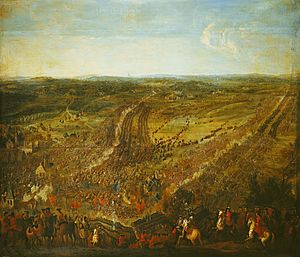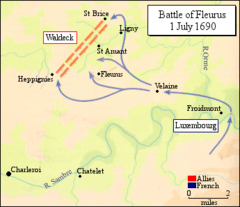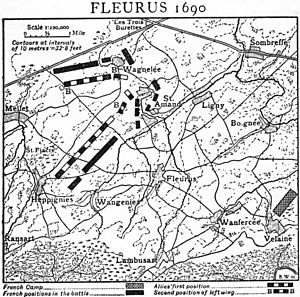Battle of Fleurus (1690) facts for kids
Quick facts for kids Battle of Fleurus |
|||||||
|---|---|---|---|---|---|---|---|
| Part of the Nine Years' War | |||||||
 Battle of Fleurus, Pierre-Denis Martin |
|||||||
|
|||||||
| Belligerents | |||||||
| Commanders and leaders | |||||||
| duc de Luxembourg | Prince of Waldeck | ||||||
| Strength | |||||||
| 30,000 35,000 40,000 70 guns |
30,000–38,000 90 guns |
||||||
| Casualties and losses | |||||||
| 3,600 6,000 7,000 |
19,000–21,000 | ||||||
The Battle of Fleurus, fought on 1 July 1690 near the town of Fleurus in modern Belgium, was a major engagement of the Nine Years' War. In a bold envelopment, Marshal Luxembourg, commanding a French army, inflicted a severe defeat on an Allied force led by Prince Waldeck.
Despite this success, Louis XIV of France ordered Luxembourg to end his campaign in the Spanish Netherlands, and instead reinforce the Dauphin on the Rhine. The Allies withdrew to Brussels unconcerned by the defeat, since they were convinced their own losses could be replaced more quickly than those suffered by the French.
Contents
Background
In 1690, the main theatre of the Nine Years' War moved from the Rhineland to the Spanish Netherlands. Defeat at Battle of Walcourt in August 1689 led to Marshal Humières being replaced as commander by Marshal Luxembourg, who retained the position until his death in 1695. His army contained 34 battalions and 94 squadrons, while if necessary he could call upon support from Marshal Boufflers on the Moselle. With King William absent on campaign in Ireland, Prince Georg Friedrich of Waldeck was given command of Allied forces in the region.
Prince Waldeck had hoped to delay the campaign to enable the Elector of Brandenburg to move on the Moselle and tie down Boufflers, but Luxembourg's early manoeuvres had allowed Boufflers to move between the rivers Sambre and Meuse to support the French commander. Waldeck, meanwhile, left his assembly point at Tienen (Tirlemont) and advanced to Wavre. After dispersing his troops to live off forage, the Allied army reassembled and advanced to Genappe on 8 June.
In mid-June Luxembourg split his forces. Humières was relegated to supervise the garrison of the Lines of the Lys and the Scheldt, whilst the main French army left Deinze and marched south, crossing the Sambre at Jeumont on 23 June. Meanwhile, detachments from Boufflers force under Rubantel had augmented Luxembourg's army, which continued its march, camping at Boussu on 27 June.
As Luxembourg manoeuvred south of Mons and Charleroi, Waldeck moved his camp between Nivelles and Pieton on 28 June. That same evening, Luxembourg personally led a detachment from Gerpinnes with pontoons to establish a bridge across the Sambre at Ham. A fortified position at Froidmont (garrisoned by about 100 men) was soon compelled to surrender after artillery was brought across the river; a simultaneous attack by French dragoons seized an enemy redoubt that had been abandoned at the approach of Luxembourg's army. With the bridgehead secure, the rest of the French army (apart from the heavy baggage that had remained on the south bank at Ham) crossed the Sambre on 30 June. (See map).
Waldeck decamped and moved towards the French bridgehead. French and Dutch cavalry sent out to reconnoitre the area crossed swords in an inconclusive action near Fleurus, but by evening the French cavalry had withdrawn to Velaine where it was joined by the rest of their army, only 3 kilometres (1.9 mi) from the Allies.
Battle

On the morning of 1 July, Luxembourg marched his forces towards Fleurus. Waldeck had set up his 38,000 troops in the two customary lines on the high ground between the village of Heppignies on their right and past the chateau of St Amant on their left; Waldeck's front was covered by the Orme stream whose elevated banks made a frontal assault all but impossible.
Luxembourg decided to attack both flanks of the Allied army simultaneously, an audacious plan whose success required secrecy and deception. The columns of the first French line split to take position between Heppignies and Fleurus, with some troops moving up towards St Amant. The two columns of Luxembourg's right veered off to the north across the Orme, their passage covered by the hedges and wheat fields, and by a screen of French cavalry. Forty cannons were positioned near the chateau of St Amant, and another 30 guns positioned between the chateau and Fleurus.
Unnoticed by Waldeck, Luxembourg had enveloped his flanks. Had the Allied commander realised that Luxembourg had split his army in two, he might have overwhelmed the isolated French left before the right came into position, but he did not. After the French right wing was in position (commanded by Luxembourg himself), their artillery opened fire at about 10:00, striking the Allied infantry with great effect. The French left wing, commanded by Lieutenant-General Jean Christophe, comte de Gournay, opened their attack with a cavalry charge but Gournay was killed in the assault; his death and the salvos of the Dutch infantry disordered his cavalry who retired to Fleurus to regroup.
A French cavalry charge on the right wing however, met with more success, driving the Dutch cavalry back. The French infantry followed and Waldecks forces now found themselves enveloped. On this critical moment Waldeck and Aylva ordered the Dutch infantry to form squares. This succeeded and the advancing French cavalry was forced to break of the assault. The French infantry, ordered to march straight onto the enemy, also failed to break the squares after suffering heavy casualties. Luxembourg, noticing the senselessness of further assaults decided to break the Dutch infantry by bombarding the thick squares from close range with captured artillery. To his surprise, despite heavy casualties the Dutch retained formation, and one of his adjutants, who could no longer stand to see the bloodshed, tried to negotiate their capitulation. After the battle, Luxembourg wrote to Louivois that "he told them that they were completely enveloped, that I (Luxembourg) was there and that I would spare them. They answered him: Leave, we want nothing, and are strong enough to defend ourselves."
What followed was a stubborn rearguard action. Waldeck and Aylva moved the troops in squares in the direction of Mellet and from there to Brussels, while the Dutch battalions in the rear formed an alternating front to the French. Under this covering fire the troops under Waldeck left the battlefield, despite various failed French attacks. The Dutch right flank under Henry Casimir II and the Prince of Nassau-Usingen sought refuge in the vicinity of the guns of Charleroi.
Aftermath
Fleurus was one of the bloodiest battles of the age, with enormous losses on both sides. According to Austrian historian Gaston Bodart, the French had 3,000 men killed and another 3,000 wounded, and the allies suffered 6,000 killed, 5,000 wounded and 8,000 captured. Périni writes that 612 officers and 3,000 soldiers were killed or wounded on the French side, and that the allies had 5,000 killed and 9,000 captured, but does not mention a number of wounded. Additionnally, the French took 48 guns and 150 flags or standards. French historian François Guizot described Fleurus as a complete French victory, but one devoid of result. Louvois, Louis’ war minister, wanted to order Luxembourg to immediately besiege Namur or Charleroi, but Louis, concerned about the dauphin's forces on the Rhine, ordered Luxembourg to detach part of his forces and forgo a major siege. Louvois objected, but King Louis wanted to be sure that nothing ‘disagreeable’ happened to his son's command. Nevertheless, Luxembourg was able to put much of the land east of Brussels under contribution.
Waldeck eventually retired on Brussels, where his injured troops were replaced with men from fortress garrisons. 15,000 Spanish troops under the Marquis of Gastañaga joined the main Allied army, as did the Count of Tilly with troops from Liège and Brandenburg on 22 July. On 2 August, the Elector of Brandenburg's forces combined with Waldeck, whose Allied army now numbered 70,000 men. With this force, the Allied army marched to Genappe, proceeding on to Nivelles on 7 August. After the battle, there was modest satisfaction in the Dutch Republic. The French had suffered more soldiers killed or wounded according to the Dutch, and the French army was in no better shape than that of the Allies to continue the campaign.
The remainder of the campaign season in the Spanish Netherlands was relatively quiet. Boufflers temporarily combined his forces with Luxembourg, but in late August he returned to the area between the Sambre and Meuse rivers. After a series of minor skirmishes, both the Allies and the French returned to winter quarters in October; Luxembourg careful to station his men on enemy territory, while the Allies quartered in and around Maastricht. The Hanoverians returned home, while many from Brandenburg and Lüneburg found quarters in the fortresses of the Spanish Netherlands.
The French pressed the prisoners of war captured at Fleurus and previous occasions into their service. They sent the Germans to the army in Catalonia, the Walloons to Germany and the Dutch to Savoy. Many however escaped and made it back to Allied territories.
See also
 In Spanish: Batalla de Fleurus (1690) para niños
In Spanish: Batalla de Fleurus (1690) para niños




